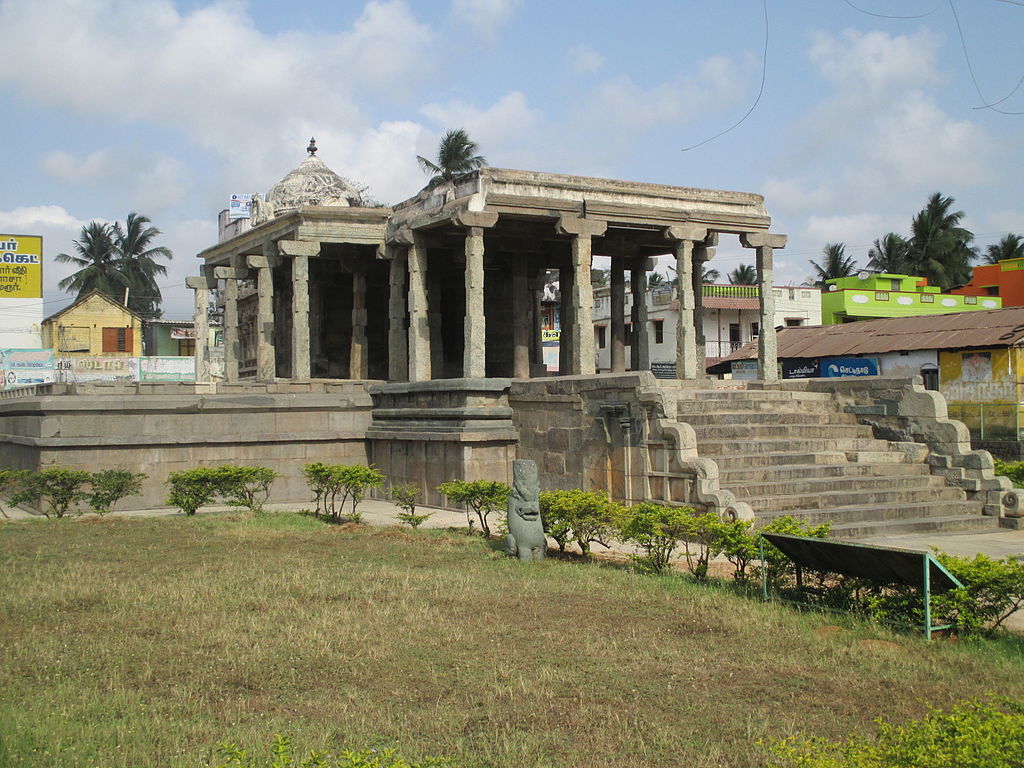Cultural Achievements of the Pallavas
After decline of Satavahanas there arose a number of kingdoms. The Pallavas were one of them. They were feudatories of Satavahanas who came into power after the downfall of their overlords.They dominated the south India between 6th to 8th century CE. Their contribution lies in both political and cultural arena especially in post-Gupta period when north India’s vigour and strength had receded in background.
Debate around their origin and homeland
-
Primarily there are two theories, (i) foreign, and (ii) indigenous, about their origin.
-
Some scholar identify then as descendants of the Pahlavas, a Persians tribe. They argue that the word Pallava is a Sanskritized form of ‘Pahlavas’.
-
ie it is merely based on superficial verbal similarity.
-
-
Some other like V. Smith rejects the theory of foreign origin. He opined that the Pallavas were an indigenous people of the south connected with the Kurumbas and allied in blood to the robber tribe of the Kallars.
-
Another view suggest that the Pallavas were of Naga origin based on a reference to Naga-Chola alliance in Manimekhalai, which appears to be more realistic given the fact that Nagas in the reference can be adduced to the Andhras and the early Pallavas ruled the region of the lower Krishna valley.
-
Another view suggest that Pallavas came from the North and were of Brahmanical origin.
-
This theory is based on the Pallavas claim of Brahman ancestry, patronizing Sanskrit leaning and performance of Asvamedha sacrifice. ©crackingcivilservices
-
-
The theory about indigenous origin is the most accepted one.
Cultural achievement
Patronage to temple architecture:
- The Pallava kings, especially Mahendravarman I (600–625 CE), Narasimhavarman I (625–670 CE), and Narasimhavarman II Rajasimha (700–728 CE), were great patrons of the arts.
- The foundation of the Dravidian style of architecture in South India was laid by Pallavas. They comprise cave temples, monolithic temples, and structural temples.
- During Pallavas 3 forms of temple temple architectures developed in 3 phases:
-
First Phase– Cave temples known as Mandaps (600 AD-640 AD):
- Pallava cave shrines are smaller and less complex in plan than those at Ajanta and Ellora.
- The relatively plain caves are represented by
- Lakshitayatana temple at Mandgappattu,
- Lalitankura’s cave at Tiruchirapalli, and
- some caves at Mamallapuram.
- The massive pillars in these caves are square at the bottom and top, and chamfered into an octagonal shape in between.
- The cave façade is generally plain, dvarapalas usually marking the two ends.
- The larger caves have columns inside as well, leading into a sanctum guarded by dvarapalas and dvarapalikas.
- The sanctum contains a linga or images of Shiva, Vishnu, or Brahma. Representations of these and other deities are also carved on the walls of the hall.
- Some of the relief carving, for instance the scene of Shiva receiving Ganga on his head in the Tiruchirapalli cave, is exceptionally fine.
-
Mahendra style:
-
Cut out of Hills
-
Consist of a main gate
-
Pillars usually square, tall & thin
-
Pillars have Capital, ornamentation over pillars
-
Statues of Dwarpala at maingate
-
Deities displayed in Mandaps
-
Peculiar forms of Dwarapalas, Prabha toranas, Cubical pillars, Lion like capital of pillar used.
-
Siva temples: Satyagirinathar and Satyagirishwarar twin temples, Siyamangalam
-
Vishnu temple: Mahendravishnugrha at Mahendravadi, and the Ranganatha Temple at Singavaram
-
-
Narsimha Varman Style / Mammal Style
-
Main centre – Mamallapuram
-
Mandaps more developed and show richer ornamentation
-
Animals, Nagas too depicted
- Mamallapuram:
- The more elaborate Pallava period caves are located at the port city of Mamallapuram, named after the Pallava king Narasimha I, also known as Mahamalla (great hero).
- The columns in these caves are comparatively slender. Their shaft is multi-faceted, sometimes fluted or round, with cushion-shaped capitals and seated lions at the base.
- Some of the caves, such as the Adi-Varaha cave, are preceded by a tank.
- Relief carving:
- The rock-cut caves at Mamallapuram contain many mythological scenes carved in relief:
- Vishnu rescuing the earth,
- Vishnu taking three strides,
- Gaja-Lakshmi and Durga (in the Adi-Varaha cave),
- Mahishasuramardini in the Durga cave, and
- Krishna lifting Govardhana mountain (in the Pancha-Pandava cave).
- The relief carving of the Pallava cave shrines is generally shallower than that in the Deccan.
- The main figures are slender, delicate, and elegant.
- Their headdresses and crowns are quite plain, and they wear little or no jewellery.
- The rock-cut caves at Mamallapuram contain many mythological scenes carved in relief:
-
-
Some important Mandaps
-
Panch Pandav cave at Pallav Varam
-
Trimurti cave at Mandag Pattu
-
Vishnu cave at Maman Dur
-
Adi Varah cave at Mahabalipuram
-
Ramanuj cave at Mahabalipuram
-
-
Second Phase – Monolithic free standing Rathas (Period 640 AD- 690 AD):
- Represents, Narsimnavarman style
- The reference to temples as rathas may have been based on the idea that they were representations of the celestial chariots that the deities were supposed to move around in.
-
They are Monolithic temples, Cut out of single rock
-
Characteristic feature is beautiful pillars
-
Pillars based on lion’s head
-
Scenes from Ramayan, Mahabharat, Puranas depicted
-
Colossal elephants and other animals depicted
-
At Mamallapuram there are nine rock-cut temples, of which five are clustered together.
-
The five forming the southern group (known as panch rathas) are named after Draupadi, Arjuna, Bhima, Dharmaraja and Sahadeva.

-
Panch rathas represent diversity of Dravidian architecture of the time and traces back to wooden constructions of temple chariots and were model for much bigger temples built subsequently in Tamil Nadu.
-
The earliest stage of Dravida style is visible in pyramidal tower like structure of rathas which is a typical dominant feature of Dravida style.
-
ie with Panch ratha began the Dravida style.
- Dharmaraja ratha:
- The Largest and the most popular and pyramidical shikhara is Dharamraj Rath. It has 3 storey.
- It is square in plan.
- It has open porches and a terraced pyramidal tower.
- Its pillar shafts are supported by seated lions.

- Bhima ratha:
- It is longitudinal in shape with a barrel vaulted roof.
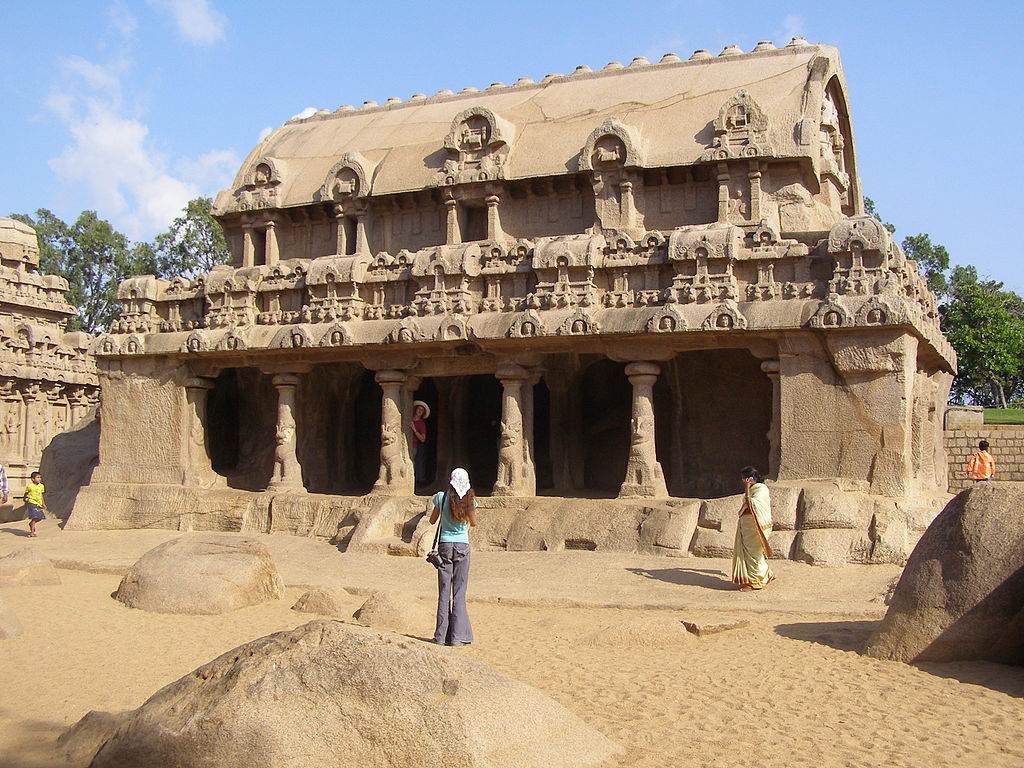
- Draupadi ratha:
- The Smallest showing no. ornamentation and like mobile rath is Dropadi Rath.
- It is a very small square structure with a curvilinear roof shaped like the thatched roof of a hut.

- Arjuna ratha:
- It is incomplete; it may have been abandoned due to the rock not being able to withstand the pressure of carving.
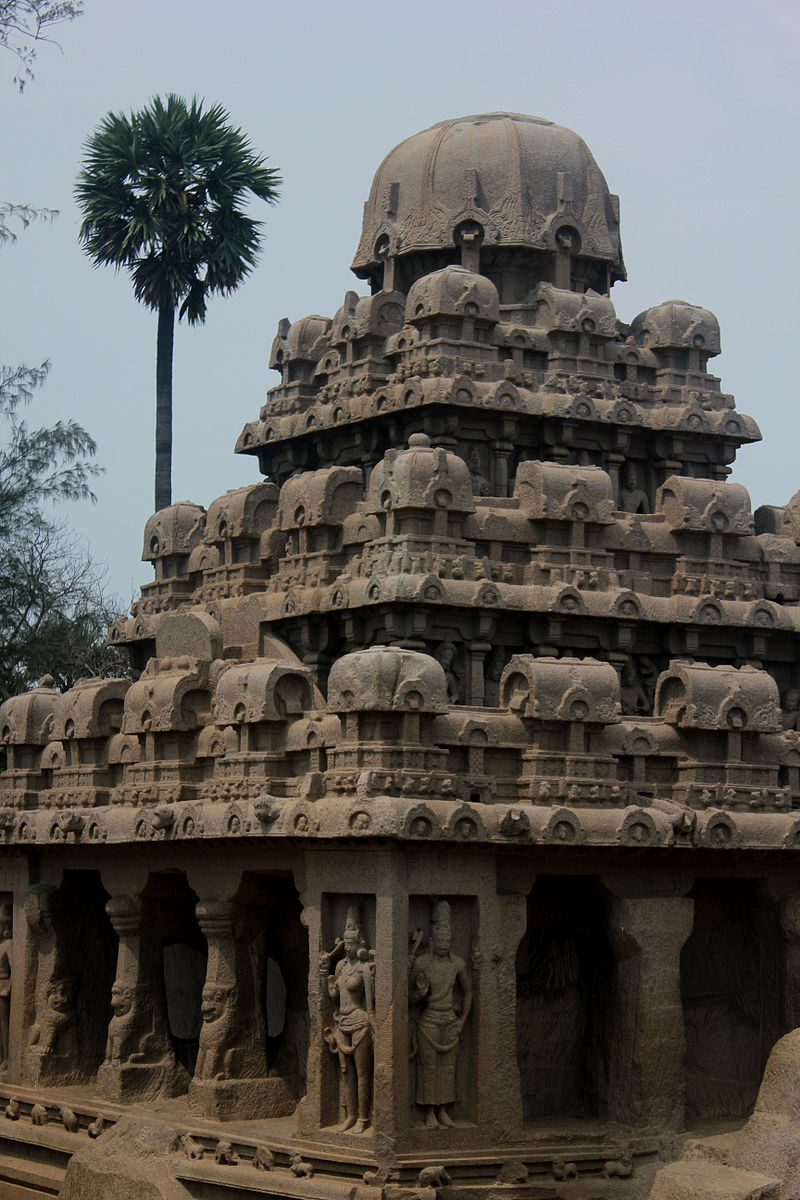
- Nakul/ Sahadeva ratha:
- It is also incomplete.
- Semi circular in shape
- no deity inscribed.
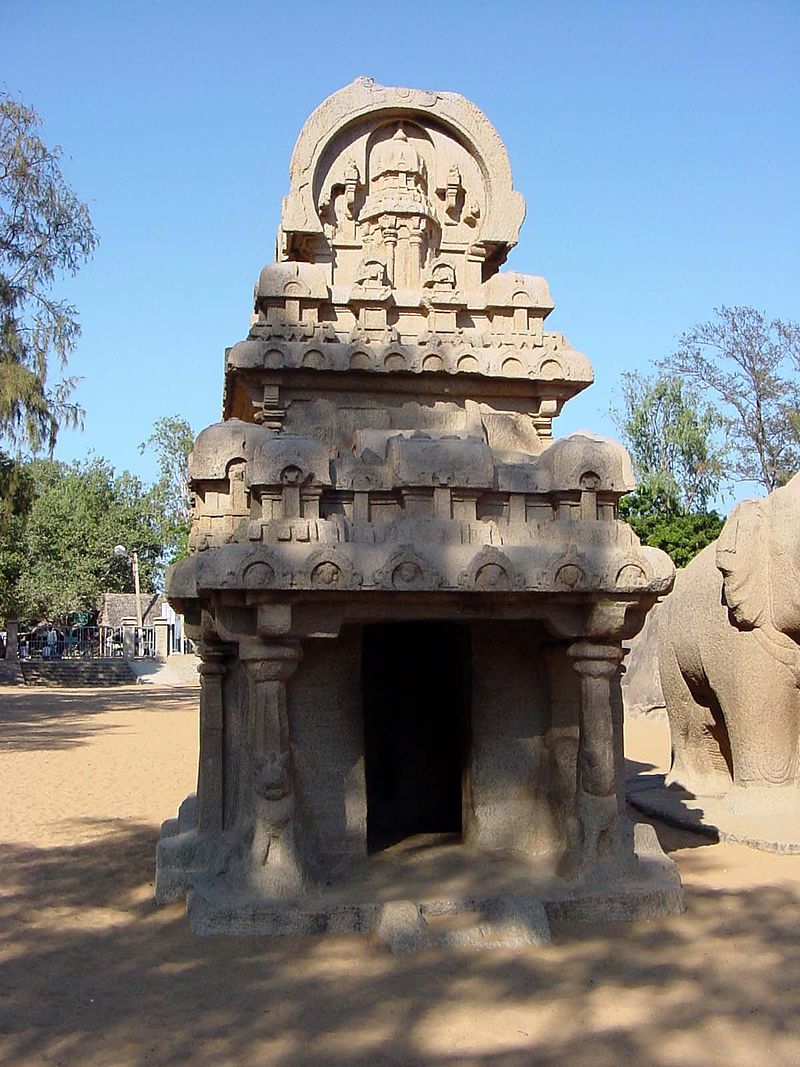
-
The three others in the north and the north-west are called Ganesa, Pidari and Valaiyan-Kuttai.
-
-
All are saiva temples
-
Bhima, Ganesh, Sahdeo, Rathas having two or more storeys and are like Chaityas.
-
The outer walls of the Mamallapuram temples are decorated with scenes from Hindu mythology.
-
The south face of the Dharmaraja ratha has a portrait which an inscription identifies as king Narasimhavarman Mamalla I.
-
3rd Phase- Structural free standing temples (Period 700 AD – 900 AD)
- Rajsimha style (700 AD – B00 AD)
- During the reign of Narasimhavarman II Rajasimha, the rock-cut technique of temple building was replaced by structural temples.
-
This represents first phase in the development of temple architecture. Mark beginning of tree-standing temples.
-
6 temples belongs to this phase: 3 are at Mahabalipuram, 2 at Kanchipuram and 1 at Panamalai.
-
Out of these 6, 3 temples are important temples: Shore Temple (at Mahabalipuram), Kailashnath Temple (Kanchipuram), Vaikunth Perumal Temple (Uttaremerur, Kanchipuram).
-
In Kailashnath, we have gateway also which is known as Gopuram and has pyramidal structure.
-
Kailasanatha and Vaikunthaperumal at Kanchipuram are perfectly integrated and the maturest example of the style.
-
-
Garbhagariha, Pyramidical Shikhara, Assembly hall are important parts.
- Shore temple at Mamallapuram:
- The Shore temple at Mamallapuram is assigned to the reign of Rajasimha.
- This has three shrine areas containing
- a stone Shiva linga,
- Somaskanda (Shiva with Uma and Skanda, a popular theme in the Pallava period), and
- Vishnu resting on the serpent Ananta.
- The two shikharas are terraced and slender.
- The relief sculptures of the temple are very eroded due to the effects of the sea breeze and sand.
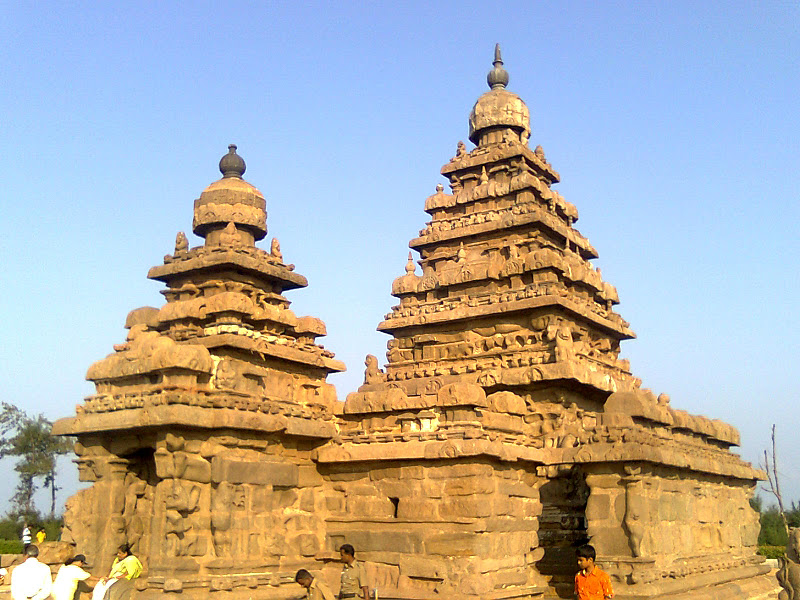
- Rajasimheshvara or Kailashanatha temple at Kanchipuram:
- It is also assigned to the reign of Narasimhavarman II Rajasimha.
- Within a large rectangular enclosure is a complex consisting of a main shrine and over 50 subsidiary shrines.
- The main temple consists of a square sanctum enshrining a linga, with an enclosed circumambulatory passage. It is surrounded by nine small shrines.
- The shikhara is in the typical southern style.
- The pillared hall and verandah preceding the shrine may have been added later.
- The enclosure walls of the complex have gopuras.
- The Kailashanatha temple is more heavily ornamented with sculptures than other structures of the Pallava period. Representations of Somaskanda are very frequent, and lions are a recurring motif on the enclosure wall.
- This temple marks an important stage in the evolution of the South Indian temple.

- Vaikunth Perumal Temple:
-
Nandivarman style (800 AD – 900 AD)
-
This represents the last phase in the development of temple architecture
-
Termples were small structures and prototype of previous ones
-
They show no novelty value.
-
Nandivarman-group marks no advance on the achievernents of the earlier period and comprises generally smaller temples reflecting the decline of the Pallavas.
-
Termples show greater development of capitals.
-
Mukteswar temple (Kanchi), Mang Teswar temple (Kanchi), Parashurameshwar (Gudi Malam) are some examples.
-
- Rajsimha style (700 AD – B00 AD)
Patronage to Sculptural art:
- Pallava sculpture has a distinctive style that is different from the Gupta period sculptures of north India.
- The faces of the human figures are oval with high cheekbones, and the bodies slender with tapering limbs.
-
Part of Temple architecture
-
Beautiful examples are the images in temples
-
Religious theme predominates
-
Gods & Goddesses, natural scenes, animals, kings & queens depicted in sculpture art.
-
Elements of Buddhist tradition, but more splendid and length more conspicuous and tendency of ornamentation diminished
-
Images in Mandaps – Images of Vishnu, Varah, Durga. Images of Dwarpalas etc
-
Images in Rathas – Best examples in Dropadi Ratha (Statue of Durga is remarkable)
-
Images in temmples – Beuatiful examples in the Temples of Rajsimha style – Perumal Temple,
-
Kailashnath Temple have beautiful images of Dwarpalas, Dancing Shiva etc.
- Open-air relief at Mamallapuram:
- Apart from the sculptures found in the temples, the ‘Open Art Gallery’ at Mamallapuram remains an important monument bearing the sculptural beauty of this period.
- This gigantic open-air relief at Mamallapuram carved across two boulders, about 15 m high and 30 m long.
- On the rock face are a profusion of figures— people, animals including elephants—all in near life-size dimensions.
- The minute details as well as the theme of these sculptures such as the figures of lice-picking monkey, elephants of huge size and the figure of the ‘ascetic cat’ standing erect remain the proof for the talent of the sculptor.
- On special occasions, water probably flowed from a cistern on the summit into the natural cleft between the two rocks, in which are carved a naga and a nagini figure.
- The scene represented in this relief has been interpreted in two different ways—as the descent of the Ganga or as Arjuna’s penance.
- Arjuna’s penance:
- The penance is part of a story in the Mahabharata and forms the theme of the Kiratarjuniya.
- Arjuna performs a penance to obtain Shiva’s weapons.
- A boar is sent by some asuras to kill him.
- Shiva intervenes to protect Arjuna, disguised as a kirata (hunter).
- Both claim to have shot the boar, and a conflict erupts. Shiva wins and reveals his true self to Arjuna.

Patronage to Fine art:
- Music, dance and painting had also developed under the patronage of the Pallavas.
-
Painting:
-
Associated with the temple architecture
-
Painting depicted on the walls and roof of the temples
-
Depiction of Gods & Goddesses, Lotus, Ducks, Geometrical designs
-
Religious & Secular social themes
-
Mainly in the form of wall painting with Fresco-Secco technique.
-
Beautiful examples in Kailashnath temple and Sittanavasal Jaina temple.
-
Mahendravarman I got title of Chitrakarapuli (tiger among artists) it reveals his talents in painting.
-
This title is very significant because the paintings on the ceiling of a rock-cut temple at Sittanvasal are attributed to him.
- The commentary called Dakshinchitra was compiled during the reign of Mahendravarman I
-
-
-
Music:
-
Mahendravarman I is also regarded as an expert in music. The music inscription at Kudumianmalai is ascribed to him.
-
The Kudumianmalai inscription referred to musical notes and instruments.
-
-
The Mamandur inscription contains a note on the notation of vocal music.
-
The Alwars and Nayanmars composed their hymns in various musical notes. The Bhakti movement led to the popularization of musical instruments like the flute.
-
-
Dance and drama also developed during this period.
-
The sculptures of this period depict many dancing postures.
-
the dance form of Bharatanatyam was performed at temples.
-
Patronage of Religion:
- The Pallavas claimed to be Brahmanas of the Bharadvaja gotra, and traced their line back to the god Brahma.
-
The Pallavas were the devotees of Hinduism. They performed different yajnas, and constructed temples and images of different Hindu gods and goddesses like Vishnu, Siva, Brahma, Lakshmi, etc.
-
They encouraged Hindu religion and Sanskit literature and, thus, helped in the process of Aryanisation in the South. The Hindu religious movements which flourished in South India in the eighth century originated within the frontiers of the Pallava-empire.
-
Kanchi became a great centre of learning in South India and its university helped in the progress of Aryan culture in the South while the city itself was accepted as one of the seven religious cities of the Hindus,
-
However, the Pallavas were tolerant rulers. They patronised, of course, Saivism and Bhagavatism but gave protection to Jamism and Buddhism as well.
-
They patronized Brahmanas and temples and made land grants Brahmadeya and Devadana.
- The number of such donations went up dramatically from the Pallava to the Chola periods.
- For instance, among the donative inscriptions at Tirupati, 11 belong to the Pallavas, and 31 to the Cholas.
- Royal land grants to temples were made in perpetuity and were associated with several tax exemptions and privileges.
- The number of such donations went up dramatically from the Pallava to the Chola periods.
-
Mahendravarman I was first Jain, but later on converted to Saivism by Saint Appar.
-
Bhakti movement also emerged during Pallava period. It was different from the devotion of early Bhagvatas in north and was strongly theistic in character. Nayanars (Shaiva saints) and Alvars (Vaishnava saints) popularised it.
Patronage to Literature:
-
During the rule of the Pallavas there was considerable literary activity, and Sanskrit enjoyed royal patronage.
- Language of inscription:
- The early Pallava rulers from 250 A.D. to 350 A.D. issued their charters in Prakrit.
- The second line of Pallava rulers who ruled between 350 A.D. and 550 A.D. issued their charters in Sanskrit. The most important ruler of this line was Vishnugopa who was defeated by Samudragupta during his South Indian expedition.
- The rulers of the third line who ruled from 575 A.D. to their ultimate fall in the ninth century issued their charters both in Sanskrit and Tamil.
-
Hence, the early Pallava inscriptions are in Sanskrit and Prakrit language, and even in the later ones, where Tamil is used the prasasti portions are in Sanskrit of a high order.
- Royal prashasti is usually in Sanskrit and the rest is in Tamil.
-
Kanchi, the capital, seems to have been a recognised centre of learning and culture from quite early times.
-
Here came the famous Buddhist dialectician, Dignaga, to satisfy his intellectual and spiritual thirst, and about the middle of the fourth century A.D. the Brahman Mayurasarman, is said to have completed his Vedic studies here.
-
-
The Vedic colleges were then located in temples endowed by the rich and devout.
-
Further, Simhavisnu is represented as having invited the great poet, Bharavi, to his court.
-
It is believed that Dandin the celebrated Sanskrit writer on poetics, lived in the reign of Narasimhavaman II Rajasimha.
-
Among other contemporaries of Dandin, we may mention Matridatta.
-
One of the Pallava kings, Mahendravarman I, was himself probably an author of repute.
-
To him has been attributed a burlesque (Sanskrit play) named the Mattavilasa-prahasana.
-
-
Outside court, this period also witnessed the growth of Bhakti literature in Tamil. Songs were composed by the Vaishnava saints (Alvars) and Saiva saints (Nayannaras) in praise of their respective gods.
-
One of the most famous of the Alvar saints was a woman called Andal. The Vaisnava devotional songs are later arranged in a text called Nalayira Prabandham
-
Those of the Saivites are preserved in the text known as Devarama.
-
- Perundevanar was patronized by Nandivarman II and he translated the Mahabharata as Bharathavenba in Tamil.
- Nandikkalambagam was another important work but the name of the author of this work is not known.
©crackingcivilservices

